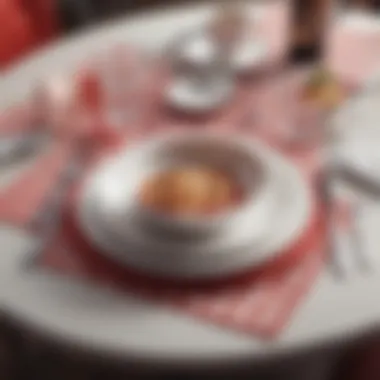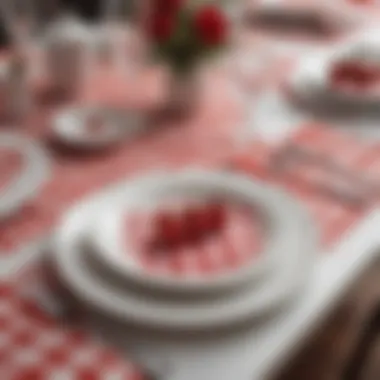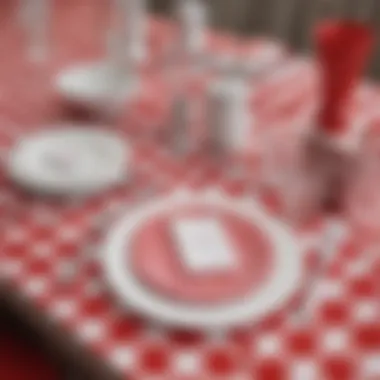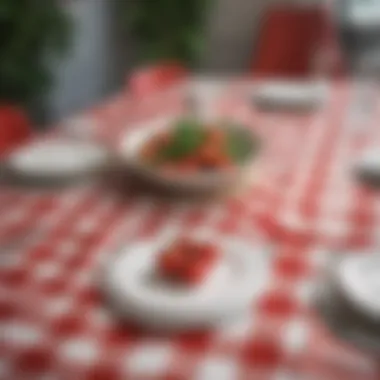The Timeless Charm of Red and White Check Placemats


Intro
When one thinks of a dining experience that balances both warmth and style, red and white check placemats often come to mind. These vibrant textiles conjure images of cozy family dinners, picnics in the park, and even elegant soirées. The unique pattern, both timeless and modern, serves as a canvas for culinary creations, elevating simple meals into memorable occasions. Exploring the nuances of these placemats leads us through an intriguing journey of history, design flexibility, and practical benefits.
As the home decor landscape evolves, so does our appreciation for such charming details. The way these placemats can tie together various themes—from rustic farmhouse aesthetics to chic modern dining—is a testament to their versatility. Furthermore, in an age where sustainability takes precedence in our choices, understanding the materials used and the eco-conscious options available makes this exploration even more relevant.
This article embarks on a detailed examination of red and white check placemats, dissecting the many ways they can enhance dining experiences. Whether you're setting the table for a casual brunch or a formal dinner, these textiles will not only provide a practical layer of protection for your surfaces but also infuse your space with an engaging visual appeal.
Prelims to Table Setting
Setting a table goes far beyond simply placing dishes on a flat surface. It's about creating an atmosphere, telling a story, and enhancing the dining experience. The art of table setting engages all the senses, making food more appealing and the experience more memorable. In this fast-paced world, where meals can often be bland and hurried, taking the time to set a table with care can elevate a simple meal into a cherished occasion. It is with this understanding that we delve into the specifics of table decor, especially focusing on red and white check placemats, which serve as both a practical and aesthetic choice.
Importance of Table Decor
Table decor functions as the spice to a gathering; it brings life to the culinary offerings. Whether you are planning an intimate dinner with close friends or hosting a grand affair, the way your table looks can significantly shape the mood. A well-set table invites conversation, elevates the meal, and turns an ordinary dining moment into a lasting memory. For instance, using red and white check placemats adds a layer of charm and warmth. This pattern whispers nostalgia and simplicity while maintaining an elegant posture that suits various occasions. In essence, table decor lays the groundwork for the kind of environment you want to cultivate—be it cozy, festive, or sophisticated.
Overview of Placemats
Placemats, in their essence, are more than mere table protectors; they are a canvas for your dining creativity. They offer practicality by safeguarding your table surfaces against scratches, spills, and heat—keeping the table pristine for years to come. In addition to their functional benefits, placemats also serve as design statements. The red and white checks, for example, can bring a touch of rustic charm to a formal dinner or infuse a sense of joy into casual dining. From casual picnics to upscale soirées, the right placemat can adapt to various settings, effectively bridging the gap between function and style. As we move through this article, we will explore how to choose, use, and maintain these charming textiles to enhance any dining experience.
Historical Context of Check Patterns
The narrative of red and white check patterns is threaded deeply into the fabric of our society, stretching from functional textile designs to motifs that resonate with aesthetic principles. Delving into the historical context of these patterns reveals not only their evolution but also their enduring relevance in contemporary setting. The check pattern itself is a testament to the adaptability of design, being able to traverse different cultures and eras, each lending its own flair and meaning.
Understanding this historical backdrop enriches our appreciation for red and white check placemats. Recognizing their origin can influence personal choices—whether one opts for a classic country feel or contemporary chic. This context serves as an anchor, offering insights into how a simple checkered design can encapsulate a wealth of meanings and interpretations, making it more than just a decor choice but a conversation starter at your dining table.
Origins of the Check Pattern
The journey of checkered patterns begins in the ancient fabric designs of civilizations like the Egyptians and Mesopotamians, where geometric shapes flourished in artistic expressions. These early patterns were not just decorative; they often carried significant meanings, representing oh so much of regional identities.
By the Middle Ages, checks had made their mark in Europe. Peasant clothing began displaying these patterns, which later transformed into symbols of status and class. Interestingly, each variant of check represented different qualities—not just utility, but artistry. For instance, Scotland's tartans tell stories of clans, while other regions might embrace checks to signify communal unity or even festive occasions. This heritage is essential, as it connects today’s red and white check placemats to centuries of tradition.
Cultural Significance Across Eras
The cultural ramifications of check patterns shine through various epochs. The Renaissance era saw a renewed interest in pattern making, leading to intricate designs that adorned the tables of the elite. In contrast, the 19th century ushered in the industrial revolution, democratizing designs. The once exclusive checks now adorned the homes of countless households, blending into varying lifestyles.
"The check pattern is a versatile, visual storyteller, presenting a tapestry of history, culture, and style."
In modern times, red and white check patterns gained traction not only as a nostalgic nod to simpler times but also as a versatile element of multifaceted design. They have been embraced by countless decor styles—from rustic dining nooks to modern eateries. People today find a sense of comfort through these patterns, evoking memories of gatherings and shared dinners.
Through various settings, the significance of these patterns becomes evident. Red and white checks are not just statements of taste, but resonances of heritage interwoven with our daily lives, connecting past to present in ways that elevate any dining experience. Whether in a cozy kitchen or a formal dining room, they bring a kind of elegance that is both familiar and sophisticated.
Aesthetic Appeal of Red and White Checks
The aesthetic appeal of red and white check placemats transcends mere decoration; it speaks to the heart of hospitality. These vibrant textiles resonate with both warmth and vibrancy, charming anyone seated at the table. At first glance, the bold contrast of red and white captures attention, evoking feelings of coziness. Their presence is almost magnetic, inviting guests to gather 'round and enjoy a shared meal. This allure is rooted in their design richness, pairing perfectly with myriad tableware styles and settings.
Color Symbolism in Design
Colors carry meanings and evoke emotions. Red, in particular, is often associated with warmth, passion, and a zest for life. When combined with white, it fosters a balance between energy and tranquility, making it an excellent choice for placemats. Red and white checks can bring a lively ambiance to any dining experience. They create a backdrop that stands out without overwhelming the senses. This careful interplay of colors can transform an ordinary meal into a delightful experience.
Compatibility with Various Decor Styles
Red and white check placemats can seamlessly meld into various decorative themes, enhancing the overall dining experience. Here’s how they fit into different styles:
Rustic
In rustic settings, red and white checks evoke feelings of nostalgia and simplicity. The characteristic warmth of social gatherings around a farmhouse table is elevated by these placemats. Their unique feature lies in their ability to reflect the natural beauty of rustic décor. The checks bring a casual charm, making it a popular choice, especially for outdoor barbecues or family reunions. The advantage is clear: they embody a sense of togetherness, reminiscent of country living.


Contemporary
On the flip side, contemporary designs thrive on minimalism and bold statements. Red and white check placemats can provide a surprising twist in modern settings, often regarded as an unexpected yet refreshing choice. Their clean lines and geometry complement sleek, modern tableware brilliantly. However, the challenge lies in maintaining balance; an overtly busy table might clash with contemporary minimalism. Thus, moderation is key.
Traditional
For those who lean towards a traditional aesthetic, red and white checks can be a harmonious fit. Their classic appeal can complement elegant china and formal cutlery, contributing to an air of timelessness. Here, the unique feature is their versatility, able to ground an otherwise ornate table setting. The key characteristic of this pairing is continuity, with checks maintaining the sense of familiar elegance without detracting from the overall traditional ambiance. But it's essential to avoid overly cluttered designs, which might detract from their classic charm.
"Red and white checks remind us that the joy of dining often resides in the simplicity of design that fosters connection."
In summation, the aesthetic allure of red and white check placemats offers a striking blend of nostalgia, modernity, and tradition. Understanding how these elements intertwine in design is crucial for creating inviting and memorable dining atmospheres.
Functional Aspects of Placemats
Placemats do much more than serve as decorative pieces. They play a vital role in protecting your dining table while also contributing to the overall aesthetic. Understanding their functional aspects can elevate your dining experience, giving it both style and practicality. Here are two key factors to consider when selecting and using placemats in your dining space.
Protection for Table Surfaces
One of the primary functions of a placemat is to shield your precious table from potential damage. By placing a red and white check placemat underneath your dishware, you're providing a barrier against scratches, heat, and spills. Whether hosting a casual family dinner or a fancy brunch, savvy hosts recognize the importance of safeguarding the table's surface.
Beneath the charm of those checks lies practicality; the fabric absorbs moisture and catches food particles, reducing clean-up time. It’s not merely about aesthetics; it's about ensuring your table isn't left with pesky rings from water glasses or irremovable stains from sauces.
"A good placemat is like a sturdy shield—protecting your table as you create memories with good food and great company."
Moreover, using placemats can instantly elevate a simple dining affair. You might think it’s just a piece of cloth, but it adds texture and warmth, creating a welcoming atmosphere. When choosing a placemat, consider materials that offer substantial protection while complementing your decor.
Ease of Cleaning and Maintenance
Choosing the right placemats goes beyond mere looks—it's also about how easy they are to maintain. Red and white check placemats are particularly advantageous in this regard. Many are made from fabric that is not only durable but also easy to clean. Most cotton and polyester options are machine washable, making clean-up after a meal quick and effortless.
Here are some factors to keep in mind when considering maintenance:
- Material Matters: Opt for materials that are known for their stain resistance. Polyester, for example, often stands up well against spills without absorbing them too deeply.
- Easy Upkeep: Look for placemats that can be tossed into the washing machine. This not only saves time but also ensures they remain fresh and vibrant.
- Storage: When not in use, how you store your placemats can affect their longevity. Consider rolling or folding them neatly in a dry, cool place to avoid creases and wear.
In sum, ease of cleaning and effective maintenance ensures that your placemats continue to shine, both literally and figuratively, enhancing the beauty of your dining space for years to come.
Material Choices for Placemats
When it comes to choosing placemats, the material plays a crucial role in not just the aesthetics, but also in how well they hold up to daily use. The material can affect durability, ease of cleaning, and the overall feel of a dining setup. Therefore, understanding the different materials available for red and white check placemats can help in making a well-informed decision.
Fabric Options and Their Features
Cotton
Cotton is a staple fabric and a often go-to choice for many when selecting placemats. Its soft texture gives an inviting feeling to the dining experience. One of the key characteristics of cotton is its breathability, allowing moisture to evaporate quickly. This makes cotton placemats quite beneficial, especially in casual settings where spills are more common. Unique to cotton is its ability to hold dye exceptionally well, making colors pop vibrantly while retaining their brightness after multiple washes.
However, while cotton is washable and maintains its shape well, it can be prone to wrinkling, requiring ironing after washing, which might be a downside for some.
Linen
Linen, known for its luxurious feel, adds a touch of elegance to any table setting. The key attribute of linen is its natural luster, which gives a sophisticated look even in simple arrangements. When it comes to red and white check patterns, linen can enhance the visual impact, making it a popular choice for formal occasions. One of its unique features is its durability; linen becomes softer and often more absorbent with each wash, contributing to its charm over time.
On the downside, linen is generally more expensive than cotton and is also more prone to wrinkles, which may deter some users from choosing this material. Moreover, it may require more care in washing and maintenance to keep it looking crisp.
Polyester
Polyester is known for its practicality and resilience. This synthetic fabric is designed to withstand the trials of daily use, making it a practical option for families or frequent entertainers. Its primary characteristic is strength and resistance to wrinkling, allowing these placemats to remain smooth and presentable with minimal effort. Another notable feature of polyester is its stain resistance—many polyesters are treated to repel stains, which makes cleaning a breeze.
However, polyester may not offer the same warmth or aesthetic appeal as natural fibers like cotton or linen. Some may find its look less inviting in casual settings, as it can sometimes feel more synthetic.


Sustainable Material Choices
In recent years, the conversation about sustainability has gained momentum in the realm of home decor. Consumers are increasingly interested in materials that are environmentally friendly. Sustainable choices often emphasize organic fibers that limit chemical usage, or recycled materials that contribute to a lower environmental footprint. This not only addresses ecological concerns but also often provides unique styles and textures that enhance the overall design.
- Organic Cotton: Grown without harmful pesticides, organic cotton placemats are a healthier choice for homes and the planet.
- Recycled Polyester: An option for eco-conscious consumers, utilizing recycled plastic bottles helps reduce waste while offering durability similar to traditional polyester.
Choosing the right materials for placemats shapes not just the dining experience but also aligns with personal values, making it an important aspect of table setting!
The material choice reflects not just personal aesthetic preferences, but also a commitment to sustainability and practicality in everyday life.
Selecting the Right Placemats
Choosing the right placemats can feel like picking out a needle in a haystack. There's more to it than simply going for something that looks nice on the table; it's about finding a blend of functionality, style, and personal taste. Red and white check placemats stand out in any dining setting, but how do you ensure that your choice suits your specific needs? Let’s dissect the critical elements involved in the selection process and highlight the real benefits of making an informed choice.
Sizing Considerations
When it comes to placemats, size isn't just a number. It affects both the look and the practical use of the table setting. The general rule of thumb is to allow about 24 inches of space for each seat. This means when you pick your placemats, they should ideally be around 12x18 inches or larger, giving diners enough room for their plates and utensils without feeling cramped.
However, factors like the size of your table, type of dining experience, and even the dishes being served can influence the ideal dimensions. A large dining table can swallow small placemats whole, losing that cozy vibe you aim to create. On the flip side, too large can result in visual chaos, cluttering the table and drawing attention away from the food and your guests.
"Size matters in placemats more than what meets the eye. It's about balance, harmony, and specialty of your meal!"
Personal Style and Preferences
Your placemat is an extension of your personal style. It should resonate with your home aesthetic and reflect your taste. Red and white checks can serve a multitude of vibes: from quaint farmhouse charm to chic modern elegance.
Here’s where the real fun begins. You have options that can fit right into your personal flair:
- Pattern: Check patterns can range from bold and large to subtle and small. Depending on the feel you want to create, think about which style matches your tableware and the overall kitchen or dining area theme.
- Composition: Are you all about that rustic feel? Cotton or linen placemats give off a natural tone. Or, if sleek sophistication is your game, perhaps a polyester blend could be more fitting.
- Color Contrast: While red and white checks are classic, consider what colors surround them. Would a pop of green in the centerpiece bring life to the table? Or do you want to keep it monochromatic for a more understated approach?
Ultimately, selecting the right placemats isn't just about enhancing your dining experience; it's an opportunity to express yourself and bring the entire mood of the meal together.
Incorporating Placemats into Various Settings
Understanding how to incorporate placemats into various settings is key to transforming any dining occasion. Placemats go beyond mere utility; they serve as a bridge between the table and the environment, effectively setting the mood for both casual and formal events. Their versatile nature can elevate the dining experience, drawing attention not just to the food, but also to the overall aesthetic of the table. With red and white check placemats, a blend of classic style and modern simplicity can be achieved, allowing them to be appropriate for a range of settings from family meals to sophisticated gatherings.
Casual Gatherings
When it comes to casual gatherings, the atmosphere should feel easy-going and friendly. Red and white check placemats can play a magnificent role in achieving this vibe. Picture a backyard barbecue or a picnic in the park where the sun’s warmth mingles with laughter. The bold pattern of red and white checks brings a touch of brightness that encourages a relaxed feeling.
In a more laid-back setting, placing these placemats on tables adorned with natural wood or even simple picnic tables can enhance the rustic charm of the moment. They offer a lively contrast to simple tableware, making every meal feel special without being overly guarded. Here are some benefits to keep in mind:
- Easy to Clean: Typically, red and white check placemats can be made from materials like cotton, making them easy to wipe down or throw into the wash after a meal.
- Playful Aesthetic: The bold colors can evoke a sense of playfulness, perfect for games or informal gatherings where fun is in the air.
- Color Coordination: Red and white checks pair well with a variety of dishware, even patterned bowls or plates, which allows for creative expression in table settings.
Creating a table setting for a casual gathering is not just about the food. It's also about the whole experience. Often, a table that looks inviting will encourage guests to linger longer, share stories, and create memories.
Formal Occasions
In contrast, formal occasions call for a different approach. When utilizing red and white check placemats in a refined setting, they can infuse a bit of cheer without compromising elegance. Consider a dinner party where the table is dressed in crisp white tablecloths, and the checks provide a contrasting visual appeal that’s both classy and inviting.
In formal dining contexts, the key is in the layering; red and white check placemats can be used underneath elegant dinnerware, giving a cheerful layer beneath fine china. The checks add a delightful contrast to the often serious tone of formal dining, striking a balance that feels both relaxed and elevated at the same time. Consider the following points:
- Depth and Dimension: Using these placemats can lend a layer of texture to a dining spread, creating visual depth that eyes naturally gravitate toward.
- Subtle Personality: Opting for a checkered pattern introduces a personal touch, signalling that the hosts embrace a blend of sophistication and approachability.
- Timelessness: The combination of red and white fits well within traditional color schemes while also appealing to modern sensibilities, making it applicable across various decors.
"The choice of tabletop decor can set the tone; a well-set table speaks volumes even before the first course is served."
In essence, how one chooses to use red and white check placemats during casual gatherings or formal occasions can affect everything from guest interaction to aesthetic appeal. Thoughtful arrangements can lead to memorable dining experiences that resonate well beyond the food served on the table.


Care and Maintenance of Placemats
When we think about maintaining an inviting dining area, the significance of placemat care often gets overlooked. However, proper maintenance can ensure that your red and white check placemats not only complement your decor but also withstand the daily wear and tear. This section delves into the essentials of caring for and maintaining these textiles, ensuring they remain vibrant and functional for gatherings both big and small.
Washing Instructions
Keeping your red and white check placemats in tip-top shape starts with understanding the best washing practices to avoid any mishaps. Depending on the material, here are some tailored washing instructions:
- Cotton Placemats: Machine wash in cold water with similar colors to prevent fading. Avoid bleach to keep the colors bright and check for colorfastness first.
- Linen Placemats: Wash gently in cold water. It’s best to hand wash or use a delicate cycle, as linen is prone to wrinkling. Iron on medium heat for a crisp look.
- Polyester Placemats: These are generally more forgiving. Machine wash in warm water, tumble dry on low heat, and they can resist wrinkles well.
It's also crucial to check labels for specific care guidelines. Hygienically speaking, washing placemats every couple of uses can help keep the dining experience pleasant. Also, be mindful of using environmentally friendly detergents to minimize your impact on nature.
Storage Solutions
After cleaning, consider how you store your placemats to assure their longevity. Here are effective storage ideas:
- Folded Storage: If you have limited space, folding placemats is fine. Just ensure they aren’t creased for long periods to prevent unsightly wrinkles.
- Roll Up Method: For longer-lasting results, rolling your placemats can be a smart move. This way, they stay wrinkle-free and are easy to access during your next gathering.
- Use a Dedicated Storage Box: Keep them tucked away in a designated box or drawer. This prevents dust accumulation and keeps them out of harm's way.
In case you are using them regularly, you can hang them on hooks within your pantry or kitchen. This way, they remain visible and easily accessible for that spontaneous dinner party.
Maintaining your red and white check placemats isn’t just about keeping them clean; it’s about preserving the character and charm they bring to your dining experiences. With the right care, these textiles can last for years and still manage to add a pop of elegance to your table setting.
By taking the time to implement these washing and storage practices, you’re ensuring that your red and white check placemats remain a timeless addition to your dining decor, ready to impress whenever the occasion arises.
The Eco-Conscious Choice
When we think about enhancing our dining aesthetic with red and white check placemats, it’s essential to not overlook the growing emphasis on environmental sustainability. This section will explore the eco-conscious choices available to us, reinforcing the significance of making mindful decisions in our decor. By choosing sustainably produced placemats, we are not just acquiring attractive tableware; we are also contributing to a healthier planet, which is imperative in today’s climate.
Sustainable Production Practices
Choosing placemats made through sustainable production practices is not simply a trend; it's slowly becoming a norm we ought to embrace. These practices often involve the use of organic materials, which are cultivated without harmful pesticides or synthetic fertilizers, resulting in lesser harm to the environment and ecosystems. It’s also about fair labor practices, where artisans are compensated fairly for their craftsmanship.
- Eco-Friendly Materials: Many manufacturers now use fibers like organic cotton or linen, grown with care for natural resources. They require less water, and lesser toxic chemicals are involved in their production.
- Certifications Matter: Look for certifications like GOTS (Global Organic Textile Standard) or OEKO-TEX, which indicate that a product meets rigorous environmental and social criteria.
- Local Production: When possible, consider placemats produced locally. This not only supports local economies but also reduces carbon emissions associated with long-distance transportation.
By opting for such placemats, one can create a stunning dining experience while showcasing a commitment to sustainability in all facets of life.
Impact on Environmental Footprint
Any home accessory we choose impacts our overall environmental footprint. Red and white check placemats fabricated with consciousness can vastly lessen this footprint without compromising style. Here is how they can contribute:
- Minimal Waste Producing: Eco-friendly brands often implement processes that reduce waste. This includes using leftover fabric scraps to create smaller products instead of discarding them.
- Durable Products: Unlike conventional placemats that may wear away after a season, sustainably made options are often higher in quality and can stand the test of time, leading to fewer replacements and thereby lowering waste.
- Biodegradability: Many sustainable placemats are designed to be biodegradable, meaning at the end of their life, they can return to the earth without causing pollution.
By making a conscious choice to prioritize sustainability in our decor, we not only decorate with intention but also help pave a way towards a sustainable future.
Closure: The Timeless Nature of Red and White Check Placemats
In the grand scheme of dining decor, red and white check placemats stand out not only for their aesthetic charm but also for their practical appeal. This article closes by emphasizing the enduring allure of these textiles. Their vibrant color combination evokes a sense of warmth and hospitality, making them a staple in both casual and formal dining environments. The timeless nature of red and white checks is not merely a fleeting trend; it's a celebration of tradition and versatility that adapts beautifully to contemporary settings.
Summarizing Key Benefits
Red and white check placemats offer a variety of advantages that can elevate your dining experience:
- Versatility: They seamlessly fit into different decor styles—be it rustic, contemporary, or traditional. This adaptability means they can enhance various dining themes, from a cozy family dinner to an elegant soirée.
- Color and Pattern: The striking contrast of red and white is eye-catching and festive, enlivening the dining space. The pattern itself can bring a sense of cohesion to your table settings, tying together plates, glasses, and centerpieces.
- Functional Protection: They serve as protective layers for table surfaces, preventing scratches and stains while also absorbing heat from dishes.
- Easy Maintenance: Most fabric options used for these placemats are simple to clean, allowing for hassle-free upkeep.
In summary, incorporating red and white check placemats into your dining setup not only enhances aesthetics but also adds functional value, making them a wise choice for any table.
Future Trends in Placemats
Looking ahead, the realm of placemats is evolving. The possibilities for red and white check patterns are expanding, pushing the boundaries of their classic look into new territories:
- Innovative Materials: We may see a rise in environmentally friendly fabrics, like recycled polyester, or organic cotton that align with consumer demand for sustainability.
- Customization: Personalized placemats, featuring monograms or unique designs, could become more popular, allowing hosts to make a distinctive impression.
- Smart Features: Innovations in textiles might introduce features such as stain-resistant coatings or heat-dispersing fabrics, enhancing the functional aspect of placemats further.
"As dining socialization expands, so does the creativity behind table settings, and red and white check placemats will continue to hold a place of honor in the evolving landscape of dining decor."
In essence, the timeless nature of red and white check placemats is shaped by their versatility and practical benefits, coupled with a potential for future adaptation. As trends shift, these cherished textiles will likely remain a beloved choice among hosts who value both elegance and functionality in their dining environments.







